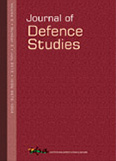The Legacy of 1962 and China’s India Policy
This article will argue that the legacy of the 1962 Sino-Indian War continues to affect China’s policy towards India even today. The three factors that led to China’s decision in 1962 to attack India—the status of Tibet, the militarization of their unresolved border and fears of containment—are present even today, albeit in slightly modified forms. This is not to argue that another Sino-Indian War is imminent because the larger strategic context within which China’s leaders took the decision to attack India in 1962 has changed.
- Manjeet S Pardesi |
- October 2012 |
- Journal of Defence Studies





